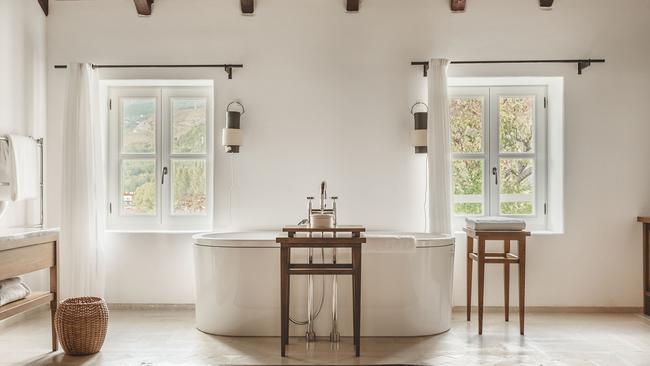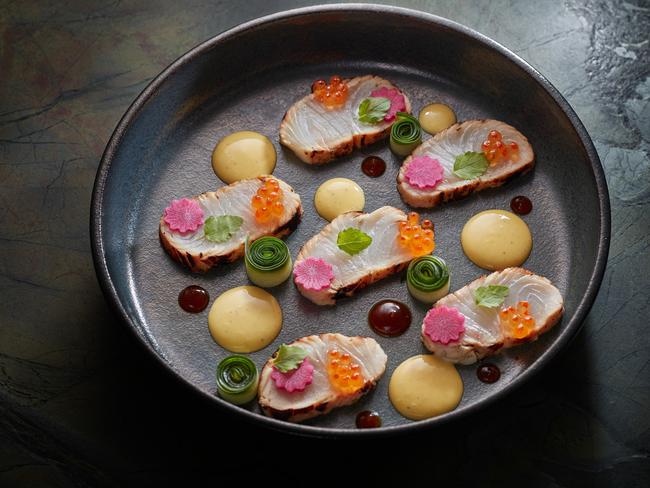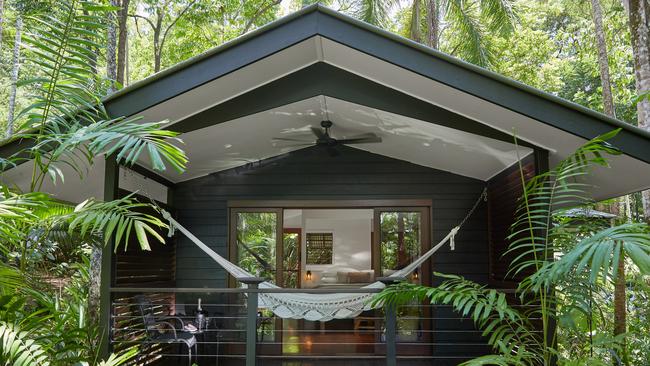The names to know when booking a great hotel
If you don’t know what to look for, choosing a primo hotel is more complicated and cut-throat than ever before.

Discover the world’s latest and greatest luxe lodgings in issue 8 of Travel + Luxury magazine, available online and in the newspaper on Friday, 26 August.
When I was in high school, my parents would load up the Holden each summer and drive from Sydney to Burleigh Heads on the Gold Coast, where we stayed year after year in the same block of “holiday flats”. We took our own bedding and even saucepans – Mum didn’t trust “foreign” kitchen implements. It never seemed to occur to us to have a meal outside our lodgings, unless it was the occasional thrill of fish and chips on the sand. One year, one of the regular families in the cohort of summer people didn’t appear and there was a lot of tut-tutting among the crowd that they’d booked a new-fangled motel around the corner. Oh, such daring infidelity. Of course, it seems hilarious now.
In today’s travel universe, when booking a hotel is commonplace, few of us think about the origins of hospitality or indeed how it has evolved. The notion of paid lodgings goes back to the era of the Nakasendo Way, an eighth-century pilgrimage route between Kyoto and Tokyo along which travellers toiled and spent nights in government-run “rest-stations”. Although not considered as such at the time, these are now acknowledged as the world’s first “hotels”. Omotenashi, the Japanese concept of hospitality, maintains that service should be immaculate but almost invisible. The experience must be sublime and memorable without being in any way pronounced or obvious. You’ll find it today at ryokan, Japan’s traditional inns that provide accommodation and meals but are almost the antitheses of hotels.
It was in the late 1380s in England, at the time of Chaucer, that inns were mentioned as resting places for pilgrims on annual treks to the shrine of Thomas Becket in Canterbury Cathedral. People were on the move in many other countries, too, and needed bed and board, often offered in convents and monasteries, but sometimes in coaching inns or at private homes, which saw the rise of hostess-run B & Bs, and youth hostels and pubs with rooms above. Hotels as we know them proliferated in the 19th century – London’s Claridge’s was born in 1812 – with all manner of modern conveniences. In New York, The Holt Hotel was the first with a steam-driven elevator to hoist luggage up its six floors.

Yet never has the accommodation game been more diverse and cut-throat as now. It’s not enough to do basic research. Travellers who want the best and most memorable accommodation need to be purposeful investigators and turn to trusted sources. So, where to begin? You could ally yourself to one of the bigger groups, such as IHG or Accor, and stick to it, amassing loyalty points and enjoying a wide range of properties across the world. In a more inclusive sense, some top-tier brands are so desirable that devoted fans claim the status of a special society. Some Aman fans like to be known as Amanjunkies. A Bali-based friend of mine with a passion for Singapore’s Alila hotel brand refers to himself as an Alila-ite. In 2019, he travelled to Oman purely to stay at mountaintop Alila Jabal Akhdar and beachside Alila Hinu Bay. “I booked the resorts and then had to work out how to get to Oman as I didn’t know where it was,” he admits.
In these cases of obsessive brand loyalty, guests can count on standards of service delivery and five-star comfort, but there’ll always be surprises in terms of the setting and a design unique to local culture and landscape. But there’s latitude, too, to think beyond brands and opt for smaller and more idiosyncratic options, especially when your chosen destination is outside well-trodden realms. Often this can be one of a kind, such as stand-alone hideaways of the likes of The Sanchaya on Bintan Island, Indonesia, Casa Angelina at Praiano on the Amalfi Coast, or privately run safari camps in Botswana and Tanzania.
“Everyone is ‘curating’ everything from mini-bars to in-room dining menus as though their role equated to that of art historian or gallery manager.”
Looking at architectural styles, the lodge is big, and I don’t mean in terms of volume. New Zealand, a destination with wild coastlines and no real resort culture, has led the charge with its contemporary lodges that mimic old-style rustic redoubts built for fishing and hunting, but increasingly opening in wine regions and forested lands. It’s no overstatement to say the Kiwis lead the world in accommodation of this ilk, but Australia has made a charge, too, putting a focus on more varied habitats, from tropical islands and rainforests to the Red Centre, wildlife-rich wetlands and tracts of bush. South America is also in the frame, offering world-class examples with the likes of Tierra Atacama in Chile, and Ecuador’s Mashpi Lodge.
Can a group of tents be a lodge? Yes, it can if all the creature comforts are present and correct. The old template of a reception desk, conference facilities, business centre and besuited general manager is well and truly out the window, or at least the canvas tent flap. Other factors to be considered in hotel design and delivery are “bleisure” (business and leisure) and digital-nomad guests who demand central locations close to transport, grab-and-go breakfasts, lobby “socialisation spaces” for catch-ups, swift connectivity and all the techno bells and whistles for busy bees on the hop. City hoteliers who ignore this market do so at their peril.

Another challenge in navigating the landscape is deciphering its increasingly obtuse, orotund and even deceptive language. One palm tree and a colourful cocktail do not a “resort” make, particularly when it’s a converted shipping container in a holiday park. Everyone is “curating” everything from minibars to in-room dining menus as though their role equated to that of art historian or gallery manager. Also meaningless is the term “boutique” when it can be airily applied to, say, a 500-room hotel. Words like heritage, homely, personalised and hip are thrown about with no regard to accuracy. The line between residential and commercial spaces has also blurred beyond recognition. Witness the advent of hotel-run private residences, which are mini versions of popular brands. Raffles, Four Seasons, Mandarin Oriental and Aman are among the big players, with more in the pipeline. Aimed at the super-wealthy, and designed by leading architects, this concept is heaven on Earth for hotel addicts who want to live or holiday in a scaled-down version of their favourite accommodation. At Aman Miami Beach Residences, due to open in 2024, buyers will “benefit from a full immersion into the Aman lifestyle”. So, why just stay at a hotel when you could effectively move in? How very 2020s.
Staying Power
The sustainable choice
Soneva Resorts, with properties in Thailand and the Maldives, is a major player in the realm of environmental stewardship. In the latter destination, Soneva Fushi has partnered with Swiss-based Coralive to protect and regenerate coral-reef habitats with the aim of becoming the largest coral nursery using mineral-accretion technology in the world. The resort has one of the largest solar power plants in the Maldives, protected turtle-nesting reserves and a brilliant “waste to wealth” eco-centre, with tours available. It’s not earnest but it is enveloping, and guests are encouraged to get on board, as it were, and do their bit for the planet.
All about the fit-out
The Design Hotels international portfolio is true to its name – each member property has strong architectural credentials and bespoke interiors conceived by leading local creatives. The scope is broad, including properties hunkered amid settings of great natural beauty. For adventure-seeking design aficionados, consider L’Ovella Negra Mountain Lodge in Andorra’s Incles Valley and Ion Adventure Hotel in Selfoss, Iceland, where viewings of the aurora borealis are on the agenda.
Wild and wonderful
Asia-based US designer and landscaper Bill Bensley has created the Bensley Collection, and masterminded projects as diverse as Shinta Mani Wild jungle camp in Cambodia and his award-winning Capella Hanoi, a city-centre fantasy of opulence and colour. To see his name associated with a property is to expect the unexpected and be saturated with surprises. The Bensley method is about philanthropy, too, as well evidenced by Shinta Manti Wild’s anti-poaching and habitat protection alliances and programs. wild.shintamani.com
Home and heart
Check the myriad choices offered by Luxury Lodges of Australia, with 18 accommodation members, plus True North, an upscale adventure cruiser plying the West Australian Kimberley coast. The options are surprisingly diverse, from properties on Lord Howe Island and amid the vastness of the Flinders Ranges to safari camps and a tiny hideaway backed by bushland on the New South Wales Central Coast.
Kiwi connections
The Luxury Lodges of New Zealand collection is remarkably varied and members take great pride in sustainable design with natural materials, serving regional wines and cuisine based on parish produce. There are seven lodges, including exclusive farm accommodation and fly-fishing hideaways, plus a selection of private villas, including a choice of four, with layouts of two to five bedrooms, at The Landing, an extraordinary pastoral farm and winery overlooking the Bay of Islands in the North Island.
Think small
Small Luxury Hotels encompasses member properties with an average of 50 rooms, but many with considerably fewer. When in Rome, consider a trio of SLH properties, all centrally located, diverse in style but consistent in a sense of character. Villa Spalletti Trivelli offers 15 high-ceilinged chambers in a palatial family-owned abode; the gemlike Hotel Vilon occupies a one-time Borghese royal residence. Its petite Adelaide restaurant, with adjacent Moroccan-inspired courtyard, could qualify as the Italian capital’s prettiest hotel dining venue. Hotel De’ Ricci is the ultimate in homeliness, with eight suites and the feel of a private townhouse, albeit one with a 1500-strong wine cellar of unimaginable value, in-suite wine selection, tiny bar and diner, and an urbane general manager who doubles as a highly trained sommelier.


To join the conversation, please log in. Don't have an account? Register
Join the conversation, you are commenting as Logout